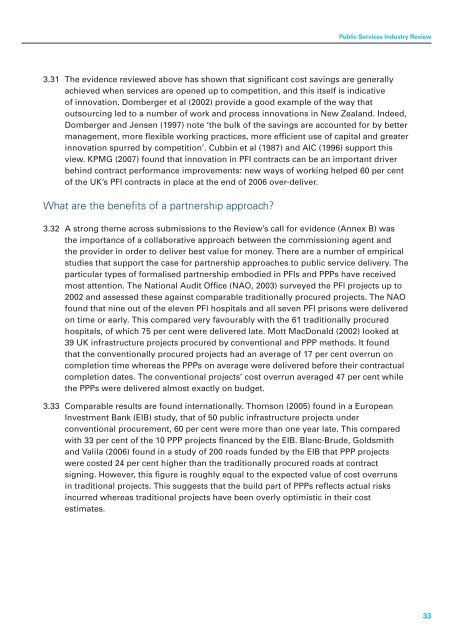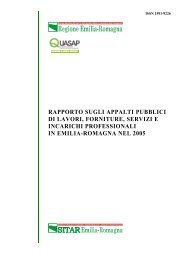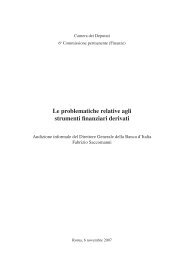Understanding the Public Services Industy
Understanding the Public Services Industy
Understanding the Public Services Industy
Create successful ePaper yourself
Turn your PDF publications into a flip-book with our unique Google optimized e-Paper software.
<strong>Public</strong> <strong>Services</strong> Industry Review<br />
3.31 The evidence reviewed above has shown that significant cost savings are generally<br />
achieved when services are opened up to competition, and this itself is indicative<br />
of innovation. Domberger et al (2002) provide a good example of <strong>the</strong> way that<br />
outsourcing led to a number of work and process innovations in New Zealand. Indeed,<br />
Domberger and Jensen (1997) note ‘<strong>the</strong> bulk of <strong>the</strong> savings are accounted for by better<br />
management, more flexible working practices, more efficient use of capital and greater<br />
innovation spurred by competition’. Cubbin et al (1987) and AIC (1996) support this<br />
view. KPMG (2007) found that innovation in PFI contracts can be an important driver<br />
behind contract performance improvements: new ways of working helped 60 per cent<br />
of <strong>the</strong> UK’s PFI contracts in place at <strong>the</strong> end of 2006 over-deliver.<br />
What are <strong>the</strong> benefits of a partnership approach?<br />
3.32 A strong <strong>the</strong>me across submissions to <strong>the</strong> Review’s call for evidence (Annex B) was<br />
<strong>the</strong> importance of a collaborative approach between <strong>the</strong> commissioning agent and<br />
<strong>the</strong> provider in order to deliver best value for money. There are a number of empirical<br />
studies that support <strong>the</strong> case for partnership approaches to public service delivery. The<br />
particular types of formalised partnership embodied in PFIs and PPPs have received<br />
most attention. The National Audit Office (NAO, 2003) surveyed <strong>the</strong> PFI projects up to<br />
2002 and assessed <strong>the</strong>se against comparable traditionally procured projects. The NAO<br />
found that nine out of <strong>the</strong> eleven PFI hospitals and all seven PFI prisons were delivered<br />
on time or early. This compared very favourably with <strong>the</strong> 61 traditionally procured<br />
hospitals, of which 75 per cent were delivered late. Mott MacDonald (2002) looked at<br />
39 UK infrastructure projects procured by conventional and PPP methods. It found<br />
that <strong>the</strong> conventionally procured projects had an average of 17 per cent overrun on<br />
completion time whereas <strong>the</strong> PPPs on average were delivered before <strong>the</strong>ir contractual<br />
completion dates. The conventional projects’ cost overrun averaged 47 per cent while<br />
<strong>the</strong> PPPs were delivered almost exactly on budget.<br />
3.33 Comparable results are found internationally. Thomson (2005) found in a European<br />
Investment Bank (EIB) study, that of 50 public infrastructure projects under<br />
conventional procurement, 60 per cent were more than one year late. This compared<br />
with 33 per cent of <strong>the</strong> 10 PPP projects financed by <strong>the</strong> EIB. Blanc-Brude, Goldsmith<br />
and Valila (2006) found in a study of 200 roads funded by <strong>the</strong> EIB that PPP projects<br />
were costed 24 per cent higher than <strong>the</strong> traditionally procured roads at contract<br />
signing. However, this figure is roughly equal to <strong>the</strong> expected value of cost overruns<br />
in traditional projects. This suggests that <strong>the</strong> build part of PPPs reflects actual risks<br />
incurred whereas traditional projects have been overly optimistic in <strong>the</strong>ir cost<br />
estimates.<br />
33
















